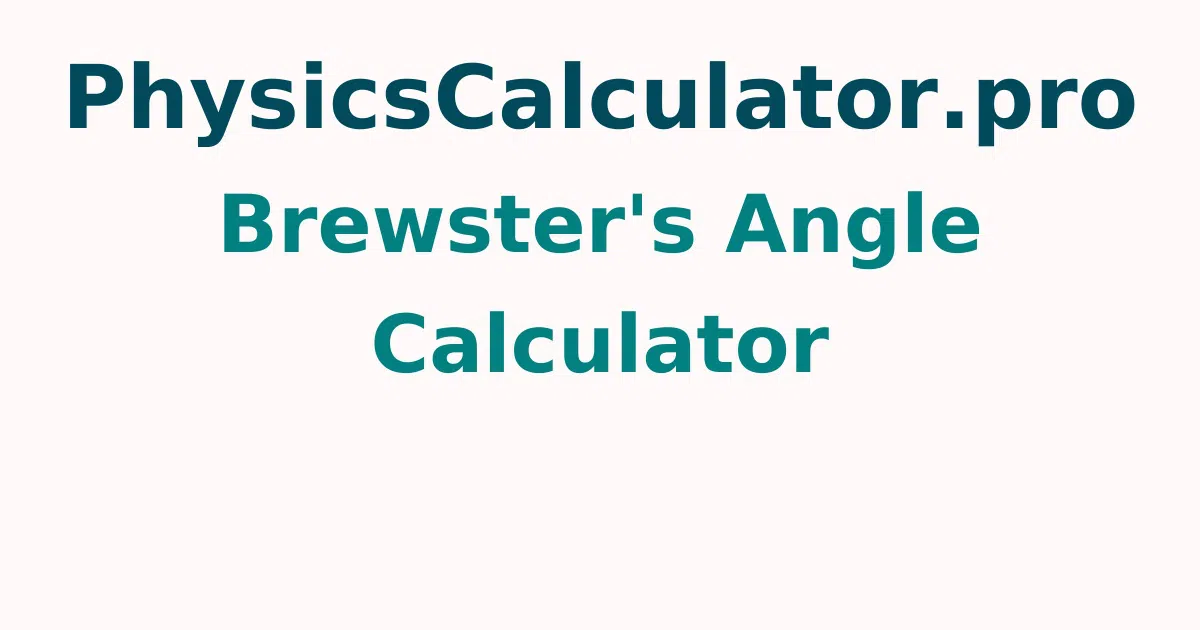Brewster's Angle Calculator
Brewster's Angle Calculator is a free tool that finds the Brewster angle of polarized light in the blink of an eye. Just provide the refractive index 1 and refractive index 2 in the below-provided input sections and tap on the calculate button.
Light Polarization | Brewster Angle
Light is an electromagnetic wave that oscillates between electric and magnetic forces. Those two fields are perpendicular to one another and oscillate in every direction possible. Unpolarized light is the term for this type of light. Only when the light's two fields oscillate in opposite directions can it be polarised.
When light collides with a medium with a differing refractive index, its propagation direction shifts, and it either reflects or refracts. The angle of reflection is equal to the incident angle when light is reflected. Brewster's angle is the angle at which the reflected light is perfectly polarised.
- αB= arctan(n2/n1) is the formula for the Brewster angle of polarisation.
- n2 = n1*tan(αB) is the formula for computing the refractive index 2.
- n1=n2/tan(αB) is the formula for refractive index 1.
For more concepts check out physicscalculatorpro.com to get quick answers by using this free tool.
How do you calculate the Brewster's Angle?
In the sections below, you'll find a detailed step-by-step process for calculating the Brewster angle of a light. Follow these instructions to get the desired result.
- Get the refractive index of the media in which light travels and the refractive index of the medium in which light is reflected.
- By dividing n2/n1.
- To check the Brewster angle of light, use the tan inverse function to the result.
Brewster's Angle Calculation Example
Question 1: Calculate the Brewster angle of light moving from water to air (n = 1.23)?
Solution:
Consider the problem
We have the inputs are
Refraction index(n1) = 1.23
Refractive index(n2 = 1.5
By using the Brewster angle formula is αB= arctan(n2/n1)
αB = arctan(1.5/1.23)
αB= arctan(1.219)
αB=50.63 degrees
Therefore, Brewster angle is 50.63 degrees.
Acceleration of the plane = 1.85 m/sec2
FAQs on Brewster's Angle Calculator
1. What is Brewster's Law, and how does it apply to you?
The maximum polarisation of light occurs when the angle between the reflected and refracted rays is 90 degrees, according to Brewster's Law. The formula for the Brewster law is μ=tanip.
2. What is the Brewster perspective?
The Brewster angle, in simple terms, is the angle where its light is polarised.The method of estimating the Brewster angle by this formula:αB = arctan(n2/n1).
3. What is Brewster Law and how does it apply?
Polarized sunglasses, in photography to lessen reflection from the surface, Brewster windows, gas lasers, and solid lasers are examples of Brewster law applications.
4. What are the many types of light polarisation?
Linear polarisation, circular polarisation, and elliptical polarisation are the three forms of polarisation. Linear polarisation occurs when the electric and magnetic fields oscillate in the same direction. In elliptical polarisation, the field directions form an ellipse, whereas in circular polarisation, the field directions rotate at a constant rate.
